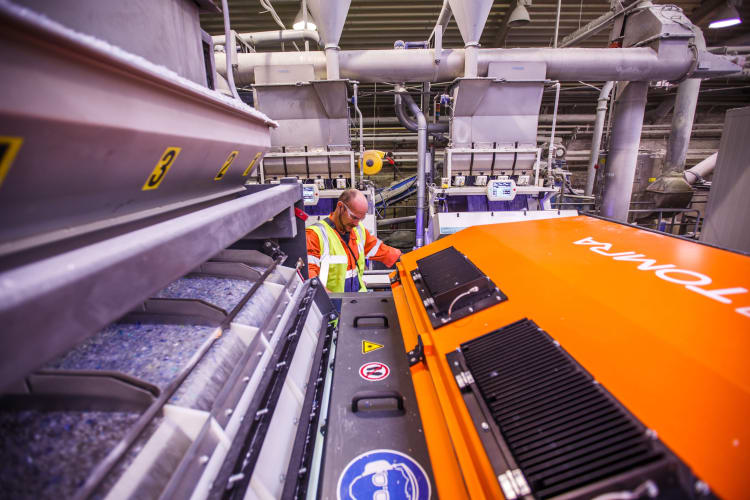Advanced mechanical recycling and collaboration along the value chain
Increasing the use of recycled content requires the entire industry to take action, design recyclable packaging, and improve the supply of quality recyclates with both new and existing instruments. Applying the Holistic Resource Systems approach to waste management combines deposit return systems (DRS), separate collections for selected material streams, and mixed waste sorting to recover plastics for advanced mechanical recycling.
Beyond dedicated collection streams, the addition of mixed waste sorting is also proving to deliver high-quality plastic for recycling. A case study with AVR, a residual waste sorting plant in the Netherlands, demonstrated that mixed waste sorting with high-performing technologies can capture 12 times more plastics for recycling, cutting down on CO2 emissions. Other sorting facilities, such as the Norwegian companies IVAR IKS or ROAF, also demonstrate the enormous potential that mixed waste sorting offers if municipalities and businesses invest in advanced technologies and processes.
Today, recyclers and sorting plant operators are faced with the task of cleaning contaminated waste to a level suitable for further processing or local trading. At the same time, brand owners and converters that buy PCR are demanding high-purity mono fractions, sorted by polymer type and colors. By adopting new sensor-based sorting technology, plant operators can effectively sort and purify high-value plastics from waste streams to supply PET or PO fractions to the market. To create more valuable products, a combination of pre-sorting and flake sorting solutions is needed. First, near-infrared (NIR) sorters separate targeted plastics from contaminants such as unwanted polymers and foreign materials. The purified plastics are then shredded, washed, and dried. The resulting plastic flakes are then processed in a secondary step with a high-precision flake sorting system that can sort flakes as small as 2mm. These ultra-flexible systems enable operators to define whether they’d like to sort materials by polymer type and/or color, creating products specifically tailored to even the most demanding requirements. The outstanding technology featured in these systems can sort a vast range of colors, including the highly demanded natural, clear, and light blue flakes, as well as all bright colors, while ensuring maximum polymer purity. Thus, operators are given the means to minimize contamination levels and supply the industry with high-quality materials they can process into virgin-like recyclates.
While most recyclers prefer plastics coming from single material streams with lower contamination levels, operators can source more materials to meet demand by ‘cleaning’ plastics of impurities. Post-consumer packaging waste, for instance, can be an excellent source of recyclable polymers and is available in large quantities. Although more contaminated compared to post-industrial plastic waste, sophisticated sorting systems can automatically recover and purify the materials by utilizing advanced mechanical recycling processes. This too would increase the availability of PCR material on the market.
Collaboration is key in plastic recycling. Improving recyclability and increasing the quantity of recycled content demands that industry go upstream because high-quality recycling begins in the design phase. Brand owners are incentivized to implement design-for-recycling to help facilitate the sorting process. The more complex and colorful the design of a product is, the more difficult it is to sort and recycle. Thus, to maximize resource recovery, product design, sorting technology, and the overall process must complement each other. With all methods, from the product’s design to its end-of-life-management going hand in hand, it is evident that change does not come from a single actor in the value chain – to innovate and transform the industry, everyone must play their part.



